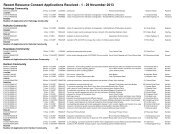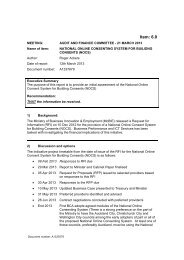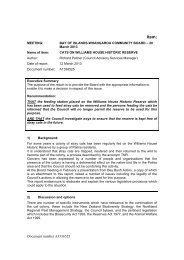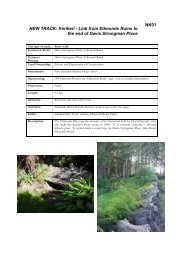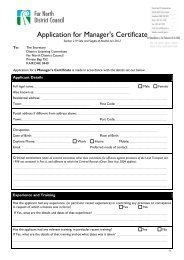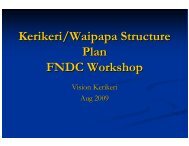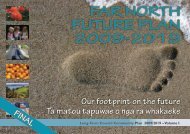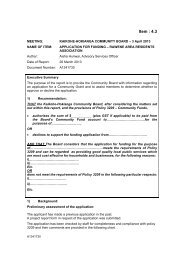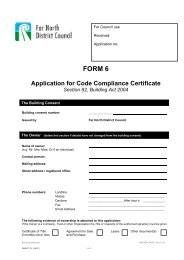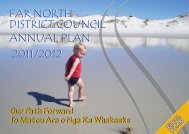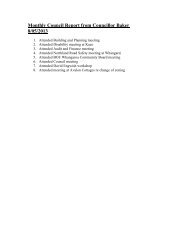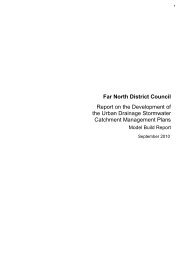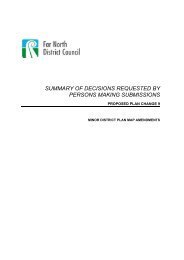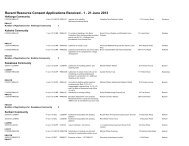Resource Consent Information Pack - Far North District Council
Resource Consent Information Pack - Far North District Council
Resource Consent Information Pack - Far North District Council
Create successful ePaper yourself
Turn your PDF publications into a flip-book with our unique Google optimized e-Paper software.
4. Additional consents needed for the proposed activity (indicate as required):Please note that if resource consent is required for earthworks, then no earthworks permit is necessary.There are some additional consents and permissions that may be required:<strong>North</strong>land Regional <strong>Council</strong> Coastal Permit: A coastal permit is issued by the <strong>North</strong>land Regional <strong>Council</strong>.A coastal permit is required for activities affecting the coast or sea bed, including (but not restricted to)activities such as reclamation or drainage of foreshore or sea-bed, the depositing of substances on theforeshore or sea-bed, the disturbance of the foreshore or sea-bed (e.g. by excavating, drilling, or tunnellingand/or the removal of that material including large amounts of sand/shingle/shell), the erection, alteration orremoval of any structure fixed in the foreshore or sea-bed, the planting of any exotic plant in the foreshore orsea-bed.<strong>North</strong>land Regional <strong>Council</strong> Water Permit: A water permit is issued by the <strong>North</strong>land Regional <strong>Council</strong>.This provides the permission to take dam or divert water.<strong>North</strong>land Regional <strong>Council</strong> Discharge Permit: A discharge permit is issued by the <strong>North</strong>land Regional<strong>Council</strong> for volumes of wastewater exceeding 3m 3 per day. A discharge permit is necessary for the dischargeof a contaminant or water into water; or for the discharge of a contaminant onto (or into) land, or into air.Discharge Permits are required for activities that may pollute the land or water. Depending on their effects,Discharge Permits may be required for activities such as discharges from a dairy shed, piggery, oxidationpond, septic tank and industrial sites, or the discharge of water into water – such as for surplus irrigationwater into streams or rivers.Note Discharge permits for volumes of wastewater not exceeding 3m 3 per day are issued by <strong>Far</strong> <strong>North</strong><strong>District</strong> <strong>Council</strong> under delegated authority from <strong>North</strong>land Regional <strong>Council</strong>. This usually applies to residentialonsite wastewater treatment systems.<strong>North</strong>land Regional <strong>Council</strong> Land Use <strong>Consent</strong>: This is required for earthworks and/or vegetationclearance (including mining, quarrying, forestry, bridging, gravel extraction, etc).<strong>Far</strong> <strong>North</strong> <strong>District</strong> <strong>Council</strong> Earthworks Permit: A permit under the Earthworks Bylaw is required for anumber of reasons, but is especially targeted at earthworks near to boundaries. The purpose of this bylaw isto control excavation, filling or cellar work on private property, and the erosion and sedimentation created bysuch work. Please note that if a resource consent is required for earthworks, no earthworks permit isnecessary as one will be issued as part of the resource consent process.Please include in this section any other reference numbers already provided to you by the <strong>North</strong>land Regional<strong>Council</strong>.5. Assessment of Environmental Effects:Every resource consent application must include an Assessment of Environmental Effects (AEE) inaccordance with the 4 th Schedule of the <strong>Resource</strong> Management Act. An AEE is a statement about the effectsa proposed activity may have on the environment in terms of the <strong>District</strong> Plan rule/s that has/have been notmet (the rules that have been breached). In other words, in relation to each rule breached, you will need toexplain how any negative effects will be remedied, avoided or mitigated. The amount of detail provided inthe AEE should reflect the scale and nature of the effects. For example, if the effects of the proposal arevery minor, then a short and less detailed AEE may be submitted. If there are major effects arising from theproposal, then a detailed analysis and discussion of these effects should be included in the AEE. This mayrequire the provision of information from specific experts (e.g. a traffic engineer).The Ministry for the Environment has produced a very helpful publication to use when writing an AEE – AGuide to Preparing a Basic Assessment of Environmental Effects. This is available from the Ministry if youemail publications@mfe.govt.nz or visit the website www.mfe.govt.nz/publications. The <strong>District</strong> Plan alsohas a section on what to include in your AEE - refer to the “Written Details” section of Chapter 4 in the<strong>District</strong> Plan.VERSION: ONENov 2008 Page 4 of 10
<strong>Council</strong> has produced a series of pamphlets on helping people to understand when resource consent isrequired. Each pamphlet contains a checklist to help you to address all the pertinent points for that issue.Use the pamphlets to guide you in your level of detail when you write the AEE. The pamphlets are availablefrom <strong>Council</strong> Service Centres and the <strong>Council</strong> website www.fndc.govt.nz, and include the following topics:• Setback• Visual amenity• Parking provision• Impermeable surfacesWhere do I start?The easiest way to do your assessment is to look at why you need one in the first place. Do this byidentifying, firstly, the part of the proposal that is breaching the <strong>District</strong> Plan. Refer to the <strong>District</strong> Plan rulesand identify those breached by your proposal. Assess the activity status (is your proposal controlled,restricted discretionary, discretionary, non-complying?). Refer to the relevant Assessment Criteria.Secondly, identify the effects that breaking the rule will have. As you think of effects, write them all down in achecklist.After reviewing all the potential effects and identifying the ones that are relevant to the proposal, consider ifthese effects will be potentially adverse or minor, and what different options you have to avoid, remedy ormitigate them. Then thirdly, identify what you could realistically do to address these effects with theapplication. Detail all the pertinent points, how they will be addressed and provide them with your application.Alternatively, you could engage a consultant planner to do this work for you.An Example:You want to build a garage in the front yard. You need resource consent because your activity does notcomply with the rule in your zone of the <strong>District</strong> Plan requiring all buildings to be setback a certain distancefrom the road boundary. This is the part of the proposal that is breaching the plan.So - what are the effects of the activity (the garage) on the environment (yourself, your neighbours, and thestreet in general) from not meeting the rule (the setback)? The effects here could include:no room to provide a garden and tree planting in front of the garage, and a visual detraction of the area whenviewed from the road as none of your neighbours have their garage in front of their houses, and the garagewill be an imposing structure as a result. The <strong>District</strong> Plan sets out assessment criteria for most breaches ofdistrict plan rules and these can be used to assist in preparation of your application.What can you do to address these effects? You could change your approach and build a garage that meetsthe rule, you could move the garage further back from the road in order to plant a number of large trees andshrubs in front of the garage (and include a plan of this landscaping with your application), and/or you coulduse materials and colours that match the house. All of these measures should soften the appearance of thegarage when viewed from neighbours’ properties and from the street.On occasion, the input of a specialist will be required to support an AEE. Consultants are available to you toprovide specialist information. Please discuss with the Duty Planner whether specialist information will berequired to support your application – call 0800-029-920.How is an AEE for discretionary consents or non-complying consents different?When preparing your AEE for discretionary consents, you need to address the cumulative effects of yourproposal – all the potential effects of the total application need to be considered, whether the rules have beenbreached or not. In these cases you will need to examine any potential effects from the whole proposal. Youshould also address the duration of the effects. For example some effects may be temporary only. For longtermprojects, or those whose effects change over time, you may need to prepare a different checklist for thedifferent phases e.g., site preparation, construction, and operation. You could use the list below to help youtry and address the effects (there may be additional points not included here):VERSION: ONENov 2008 Page 5 of 10
Modification of the built environmentAre there any existing buildings on the site? If yes, please describe and provide a site plan showing theirlocation, size and any access to the buildings. Will your proposal require the construction / extension /demolition of any of the buildings? If yes, please provide plans / diagrams drawn to scale showing thelocation, design and finished exteriors of the building(s). How will these changes affect other people (eitheron the property or neighbouring properties)?Modification and/or destruction of historical or cultural sitesAre there any special features on or near the site (e.g. archaeological sites, notable trees, historic buildings)?If yes, please describe. If you are unsure regarding the possibility of historic sites, such as pa sites andbuildings, you are advised to contact the New Zealand Historic Places Trust, who will be able to tell you moreregarding possible sites. What aspect(s) of your proposal will affect Maori culture (e.g. destroy or occupy siteof significance to Maori) or any archaeological sites, notable trees, or any other area with a recognised value(e.g. recreation or area of scientific interest)?Natural featuresWhat is the topography of the site (flat / rolling / sandy / wetland, etc.)? Will your proposal include the locationof any buildings within 30 metres of a water body (i.e. stream, river, the sea, lake, etc.)? If yes, whatdistance? What aspect(s) of your proposal will affect any ecosystems (e.g. habitats for flora / fauna)? Whataspect(s) of your proposal will affect the landscape and visual amenity of the environment (e.g. building seenfrom the coast, vegetation clearance / earthworks)?Physical featuresWhat is the area of the site? What proportion of it is covered with impermeable surfaces? Will your proposalrequire earthworks? If yes, what volume and what maximum height / depth? Are there any existing orpotential natural hazards (e.g. flooding, slips)?Vehicular movementWhat is the current use of the site and surrounding area of the property? Will your proposal require formationof an access way and / or parking area? If yes, the parking and associated manoeuvring areas will need tobe shown on a site plan (drawn to a recognisable metric scale). Design guidelines are detailed in the <strong>District</strong>Plan, Part 4 appendix 3(b), 3(d) and 3(e)Storm water and wastewaterWill your proposal require effluent and storm water disposal systems? If yes, how will waste water bedisposed of (on-site or to a reticulated system)? How will storm water be disposed of (on-site or to areticulated system)? Has an engineer designed the system(s)? What storm water flow aspect(s) of yourproposal will affect others on your property and / or your neighbour’s properties? What aspect(s) of yourproposal will affect waterways in the area?Neighbouring featuresWhat effects will the proposal have on the wider community?Smell or other air pollutionWhat smell aspect(s) of your proposal will affect others on your property and / or your neighbour’s properties?Will your proposal generate dust or odour? If yes, what will you do about it?Shading / loss of sunlightWhat loss of sunlight aspect(s) of your proposal will affect others on your property and / or your neighbour’sproperties?NoiseWhat noise aspect(s) of your proposal will affect others on your property and / or your neighbour’s properties?Visual impactWhat visual aspect(s) of your proposal will affect others on your property and / or your neighbour’sproperties?VERSION: ONENov 2008 Page 6 of 10
Loss of recreational valuesWill your proposal result in a wider community loss of recreation opportunities?Changes to the character of the street or the surrounding landscapeWhat changes to character aspect(s) of your proposal will affect others on your property and / or yourneighbour’s properties?Run-off and pollutionWill your proposal involve the discharge of silt into the environment? If yes, please describe. Will yourproposal involve the discharge of contaminants into the environment? If yes, please describe. Will you beusing, working with or storing hazardous substances on the site? If yes, please describe.Vegetation lossWhat vegetation is contained on the site? Will your proposal require vegetation clearance? If yes, what type(i.e. indigenous or exotic) and how much clearance is required?Loss of privacyWhat loss of privacy effects will the proposal have on the wider community?NOTE:If you don’t understand this process, or are having difficulty identifying potential effects, you may need toinvolve consulting professionals to help you. This will enable any necessary changes to be made to yourproposal before you have made a significant investment. Please also note that a detailed technical review ofyour application may reveal the need for you to supply further information, in which case you will be advisedas soon as possible.Consultation:Consultation is an important part of the AEE process. It is an opportunity to tell people what you are going todo and give interested and affected people an opportunity to contribute ideas to the project (e.g. dependingon the size of your project and the nature of the land these may include neighbours, community groups,tangata whenua, NZ Historic Places Trust, Transit New Zealand, Department of Conservation, etc). Includedin this guide is a copy of the <strong>Council</strong>’s “Notice of Written Approval” form that you may distribute (with anattached copy of the plans for the affected party to sign) to any potentially affected parties.6. Other information required:This is the section where you should list any additional information required by any provisions of any Acts,regulations or plans. This includes any consents issued by other authorities or any permissions required.7. Signature:Please don’t forget to sign the application.If the Owner is a Company, Trust or other Organisation, the Title or Capacity of the authorised signatory mustbe given. If an authorised signatory is to be used, please ensure that proof of authorisation is present also.VERSION: ONENov 2008 Page 7 of 10
8. Attachments:This section is there to help you ensure that you have compiled everything for a complete application. Pleasetick the boxes to the left of the list on the form for the attachments you have – number each attachment withthe same number as the section it contributes to on the form. You must submit all the information which isrequested on the checklists. If you have any problems, please call the Duty Planner on 0800 920 029.Payment:As discussed in Section 10. <strong>Council</strong> is able to receive eftpos, cash or cheque (make your cheque payable to“<strong>Far</strong> <strong>North</strong> <strong>District</strong> <strong>Council</strong>”).Certificate of TitleAs discussed in Section 2. The Certificate of Title is a record of property ownership, and for the purposes ofyour application it must not be more than 6 months old. Refer to the date in the bottom right hand corner ofyour Certificate of Title. A copy of any consent notices, building line restrictions or Transit gazette noticeslisted on the Certificate of Title must also be provided. You must show compliance with any consent noticeconditions and building line restrictions that are noted on these consents. There may also be privaterestrictive covenants that affect development of the site.Description of the ActivityAs discussed in Section 3. Please attach your description (based on the requirements of Chapter 4 of the<strong>District</strong> Plan, and the 4 th Schedule of the RMA) and any other reports you may wish to append.Requirements for DrawingsAs discussed in Section 3. Any application for resource consent should include a set of drawings illustratingthe proposal, and they should comply with the drawings section of Chapter 4 of the <strong>District</strong> Plan.Assessment of Environmental EffectsAs discussed in Section 5. Please attach your AEE (based on the requirements of Chapter 4 of the <strong>District</strong>Plan and the 4 th Schedule of the RMA) and any other information you may wish to append.Notice of Written Approval FormsAs discussed in Section 5. Please attach any completed approval forms. Please also ensure that both sidesof the approval forms have been filled in, and that all parties registered on the Certificate of Title of eachproperty have provided written approval. It is also recommended that these parties sign the plans they wereshown so that no disputes arise later as to what they have approved.Reports from Technical ExpertsAs discussed in Section 5. In some circumstances reports from technical experts may be required tosupport your application.OtherThis includes any additional information required – including copies of consents issued by other <strong>Council</strong>s,applications to other <strong>Council</strong>s, and Development Plans.9. For Field Services:This is information is required by <strong>Council</strong> staff need to have to ensure that they are safe while on site; andalso to ensure that they do not waste time driving to a locked gate. Also, please advise if there are anyrestrictions to attending the location. This information will not be part of the public record.VERSION: ONENov 2008 Page 8 of 10
10. Payment:Your application will not be accepted by <strong>Council</strong> unless the correct deposit is received. The fees charged bythe <strong>Far</strong> <strong>North</strong> <strong>District</strong> <strong>Council</strong> are outlined in the “Consolidated Fees Schedule” for this year. This documentis available on the <strong>Council</strong> website www.fndc.govt.nz or from <strong>Council</strong> Service Centers. A deposit is requiredon acceptance of all applications.Processing fees additional to the deposit may be incurred if an application requires additional actions. If theapplication is publicly notified and requires a hearing, the minimum hearing fee is to be paid before thehearing. You will be told during the processing of your application if this will be necessary.Additional fees may be invoiced during, or at the end of, the application process (in accordance with Section36 of the <strong>Resource</strong> Management Act 1991). Additional charges must be paid within 20 working days ofreceipt of the <strong>Council</strong> invoice. If you have any special requests in terms of payment scheduling for additionalcosts (if necessary), then please note them in section 10 on your form.Please be aware of the potential additional costs associated with resource consents:The costs will vary from property to property, and project to project, depending on the scale of the change.The cost may include a selection from the following:• Consultant fees;• Solicitor fees (including <strong>Council</strong>’s solicitor) and the applicant’s solicitor (for obtaining the deposit of thesurvey plan and issue of the new titles);• Construction costs of engineering works (such as driveways, roads, services, etc);• Fees charged by Land <strong>Information</strong> New Zealand;• <strong>Council</strong> fees for the costs of connection to, and extension of (where required) the public infrastructurenetwork;• The cost of obtaining a valuation for assessing the reserve contribution;• Financial and development contributions (including roading, reserve and public services contributions);• Subdivision consent application and Section 223 and 224 certificates;This is not a comprehensive list, but you must consider ALL potential costs when preparing todevelop.For Subdivision ApplicationsBefore beginning the subdivision process, it is recommended that you make an appointment to see aconsulting professional, who will advise you on how to subdivide your property and draw up a proposed planof subdivision (scheme plan). This plan and an accompanying report are submitted to the <strong>Council</strong> forsubdivision consent, which takes approximately 20 working days to process. However, the whole process tocomplete a subdivision can take many months to complete a particular proposal. After an initial assessment,you may be asked to provide further information such as geotechnical reports or flood plain assessments.The <strong>Council</strong> will also determine whether the application needs to be notified, or whether written approvals areadequate; and whether or not a hearing is required.As well as subdivision consent you may also need to apply for land use consent (See <strong>Council</strong> planning stafffor more information).The consent process is essentially a partnership between the applicant and the <strong>Council</strong>. The applicantprovides all the information required, and the <strong>Council</strong> approves the application as quickly as possible. Aproperly designed project can be checked and consented quickly.VERSION: ONENov 2008 Page 9 of 10
Please visit us, either in person or electronically; we’re here to help!HOW TO CONTACT THE COUNCIL• Call 0800-920-029 to be connected to our offices• Call at any of our Service Centres to speak to a Customer Service officer.• Visit our website at www.fndc.govt.nzWrite to,<strong>Far</strong> <strong>North</strong> <strong>District</strong> <strong>Council</strong>, Private Bag 752, Memorial Avenue, Kaikohe 0400, New Zealand.OTHER SERVICE CENTRESJohn Butler Centre Kawakawa Library & Service Centre Procter Library60 Kerikeri Road Gillies Street Cobham RoadKERIKERI KAWAKAWA KERIKERIKaeo Service Centre Kaitaia Service Centre Rawene Service CentreMuseum on Leigh Street Redan Road Parnell StreetKAEO KAITAIA RAWENEVERSION: ONENov 2008 Page 10 of 10



